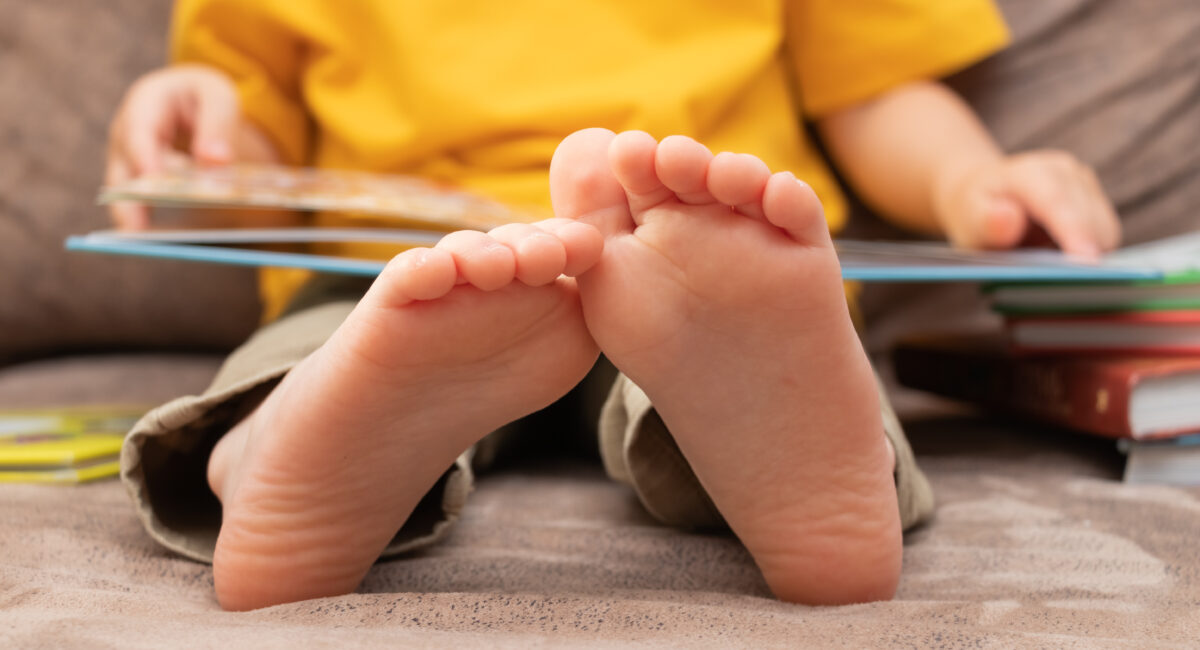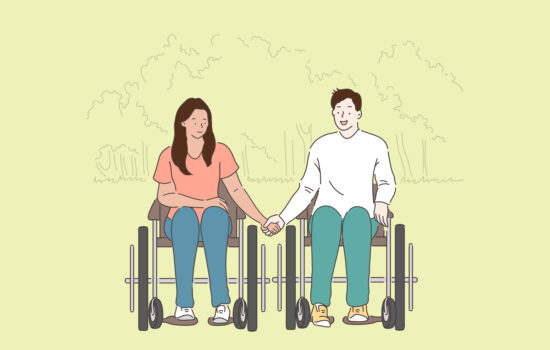Having flat feet is a natural part of development in majority of children. As most of them will outgrow this condition, should parents take a wait-and-see approach? Or when should they consider treatment? SPD’s senior physiotherapist La Min Maung shares more.
What Are Flat Feet?

Feet are considered “flat” when they do not have an arch. A foot arch is the part of the foot that is raised off the ground while standing or walking. The arch is a flexible foundation for the whole body that helps with walking.
It is normal for infants and very young children to have no apparent arches in their feet. Noticeable foot arches are not usually observable until around three years old when a child’s gross motor development such as walking, stair climbing and running becomes mature.
How Can I Check for Flat Feet at Home?
Flat feet are much easier to observe when the child is standing or walking. It is important to look out for any difficulties or imbalances the child may have especially when he/she starts standing, cruising, and walking independently. These are some quick and easy ways for you to investigate at home.
Observe and Record
- Carefully observe the child
- Take photos of the child’s feet from behind, or record videos if your child is having difficulty participating in daily activities such as playing, or stepping up and down etc
Do a ‘’Wet Footprint Test ‘’
An easy footprint test can help you determine if your child has flat feet.
- Wet the sole of your child’s feet.
- Get him/her to step onto a paper bag or a blank piece of thick paper.
Observe the shape of the foot and match it with one of these foot types. You will notice the kind of arch your child has after the test.

Does Flat Feet Require Treatment?
Should you have concerns that your child has flat feet, you may consult a healthcare professional such as your paediatrician, physiotherapist, or podiatrist. Before considering treatment, healthcare professionals will usually check if your child is experiencing pain or decreased functions associated with flat feet. It is important to understand and manage underlying causes rather than just treating the symptoms.
It is crucial to observe if there are associated issues such as knock knees (knees are nearer to each other when standing), joint hypermobility (excess joint flexibility), and being overweight. Each condition should be addressed carefully. If the child’s participation in daily activities and quality of life is affected by flat feet, it is better to discuss with healthcare professionals first.
How Does Physiotherapy Help?
The purpose of physiotherapy is to reduce pain, increase flexibility, strengthen muscles, promote joint sensation, and educate patients and caregivers.
Here are some easy and safe exercises for healthy feet which you may try out with your child at home.
Gentle Foot Massage
- Apply gentle pressure and massage the bottom of your child’s foot in a circular motion so as to activate the inner foot muscles.
Tactile Input

- Let the child sit comfortably
- Roll a sensory or tactile ball along the arch of the foot to activate muscles.
Scarf Lifts

- Position the child seated or standing.
- Encourage the child to place one foot on the floor. With the toes of their other foot, grip the scarf to lift it up from the floor.
Towel Curls

- Position the child seated.
- Encourage the child to pull towels using the toes. Pause and repeat.
Bear Walks

- Encourage the child to walk across the room on their hands and legs, like a bear.
Your child’s physiotherapist may be able to recommend flexibility exercises, stretching exercises for the ankle and foot joints, as well as strengthening exercises that target the lower limbs. It is best to ask your healthcare professionals to do a proper examination and to prescribe an exercise intervention plan.
References:
Allen J and Solan S. N.d. Physiotherapy management of paediatric flat feet (Powerpoint). https://www.peacocks.net/_filecache/316/436/892-physiotherapy-management-of-paediatric-flat-feet.pdf
Burns J, Little D, and Martinkevich P. What are ‘flat feet’ in children and are they something to worry about? The Conversation. 29 July 2016. https://theconversation.com/what-are-flat-feet-in-children-and-are-they-something-to-worry-about-60365
MacKenzie AJ, Rome K, and Evans AM. The efficacy of nonsurgical interventions for pediatric flexible flat foot: a critical review. J Pediatr Orthop. 2012 Dec;32(8):830-4. https://pubmed.ncbi.nlm.nih.gov/23147627/
Raj MA, Tafti D, Kiel J. Pes Planus (Flat Feet). StatPearl-NCBI Bookshelf, 2020. https://www.ncbi.nlm.nih.gov/books/NBK430802/
Suciati T, Adnindya MR, Septadina IS, Pratiwi PP. Correlation between flat feet and body mass index in primary school students. Journal of Physics: Conference Series 2019 Jul 1 (Vol. 1246, No. 1, p. 012063). IOP Publishing.
Cover Photo: Shutterstock





